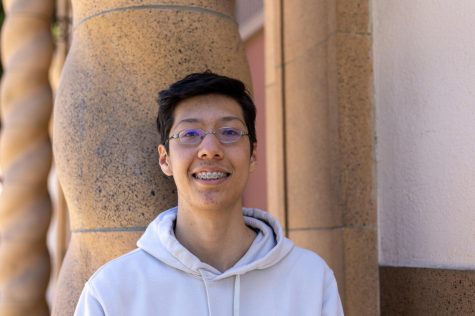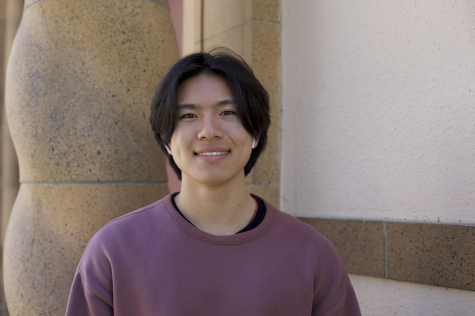Elective teachers concerned about PAUSD enrollment dropping
Senior Lara Lew-Strass talks to two Duveneck Elementary School students during Early Childhood Development’s field trip to the school. According to ECD teacher Hillary McDaniels, the trend of dropping enrollment can actually bring some benefits for schools. “We’re [the district] primarily funded through our property tax dollars,” McDaniels said. “Overall when our enrollment shrinks that actually, should be more money per student, not less money per student. But there’s also the concept of being fiscally responsible which is important to our district as well, so you need to find that balance.” (Photo: Leena Hussein)
May 26, 2023
As the recent trend of dropping enrollment continues in Palo Alto Unified School District, elective teachers are becoming increasingly concerned about maintaining classes in the future.
According to recent data from the California Department of Education, PAUSD enrollment has decreased by about 16% from 2015. During a press conference held by the Paly Voice on Apr. 28, Superintendent Don Austin said this trend is not limited to PAUSD.
“I just read a report from Southern California that a lot of their bigger school districts lost 20% of their population between 2019 and today,” Austin said. “So while ours is not a small number it is definitely in the range of our region [California].”
According to Austin, the most pressing issue with declining enrollment is maintaining unique elective courses.
“The only real immediate concern I have is that when you lose students at the secondary level, it can impact the number of students that it takes to offer elective classes,” Austin said.
According to Early Child Development teacher Hillary McDaniels, drops in student enrollment can heavily impact electives.
“All elective teachers are concerned that enrollment drop will impact their program, because with less students that’s less seats that you can fill in your classrooms,” McDaniels said. “So, like every other elective teacher, I would say it’s quite possible that it [enrollment drop] will impact my program.”
According to McDaniels, elementary schools are often hit the hardest by enrollment drops.
“In my son’s elementary school, they used to have three or four strands [classes] for every grade level and now some grades only have two,” McDaniels said. “So certainly it is a concern district-wide if there is pressure to not run small classes.”
Spanish teacher Kevin Duffy said declining enrollment in foreign language classes at the middle school level can lead to a chain reaction that affects the high school language pathway.
“It’s hard to maintain offering all the languages when you have other electives [at the] middle school level, and then that has a ripple effect when they get to high school,” Duffy said.
Paly’s foreign language program currently consists of Spanish, French, Chinese, Japanese, and American Sign Language classes. Duffy said this wide range of course offerings makes it harder to sustain each one, especially as the number of foreign language students decreases as a whole.
“I’ve seen enrollment drop in the department,” Duffy said. “I can think back many, many years for level one Spanish 15 years ago versus now, you can see there’s a downtrend there. We see a real drop off after the third year that not as many students are continuing on to AP Spanish Language and Culture, which is concerning.”
According to Duffy, PAUSD foreign language programs have a history of discontinuing languages due to a lack of enrollment.
“If one language has a smaller enrollment, and the middle school classes aren’t offered, that means at the high school level, eventually that program could disappear,” Duffy said. “When they stopped offering German at the middle school, that meant it was really hard to sustain the program. Now there’s a small program at Gunn but that’s it, whereas we used to have it at both high schools.”
Despite a district-wide drop in enrollment, McDaniels said her class sizes have remained relatively unchanged.
“While my program has continued to grow every single year, I am slightly down [in enrollment] next year,” McDaniels said. “Not as significant as the [district-wide] enrollment drop, so that’s good, but I certainly don’t love hearing that. I like a trend of more people being interested in taking advantage of the pathway.”
History teacher Stephen Foug, who grew up in PAUSD, said he remembers his high school being affected by low enrollment.
“When I was a rising freshman here [at Paly], in eighth grade to ninth grade, they were about to close Gunn and make one high school due to decreasing enrollment,” Foug said.
Although smaller classes could lead to more attention for each student, classes that are too small would be harmed, according to Foug.
“In terms of class size, smaller is better to a point. There’s kind of a critical mass if you get too much into the low twenties,” Foug said. “Then the classes can be lackluster, it can be hard to do group stuff.”
To increase class sizes, PAUSD has considered options including allowing Palo Alto city employees to send their children to the district. According to Austin, this change would help prevent school closures.
“[About] 10% of our students are coming from other places,” Austin said. “We’re trying to keep everything open, trying to backfill a little bit but we really don’t want to close a school.”
According to McDaniels, keeping unique classes open contributes to the success of the district.
“Maintaining programs to offer variety to students is great,” McDaniels said. “That’s one of the things that make our district rather special — having opportunities here that aren’t elsewhere.”


![Senior Lara Lew-Strass talks to two Duveneck Elementary School students during Early Childhood Development’s field trip to the school. According to ECD teacher Hillary McDaniels, the trend of dropping enrollment can actually bring some benefits for schools.
"We're [the district] primarily funded through our property tax dollars," McDaniels said. "Overall when our enrollment shrinks that actually, should be more money per student, not less money per student. But there's also the concept of being fiscally responsible which is important to our district as well, so you need to find that balance." (Photo: Leena Hussein)](https://palyvoice.com/wp-content/uploads/2023/05/IMG_3318-900x675.jpg)







![A protester in a chicken suit wearing a taco hat with the words “Cluck Trump” at the “No Kings” Democracy Fair in Palo Alto on Saturday. Protestor Mary Chan said she and her husband are horrified at the state of science and medicine in America. “What he [Trump] is doing by defunding scientific research is destroying our academic medical centers, and he’s [Trump] bankrupting rural medical centers,” Chan said. “We will have lasting negative impacts on American health for decades.”](https://palyvoice.com/wp-content/uploads/2025/10/11562FFE-9912-4152-BB01-582426B52ECB_1_105_c-225x300.jpeg)